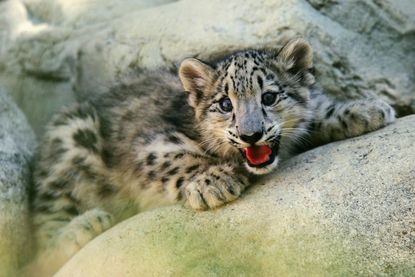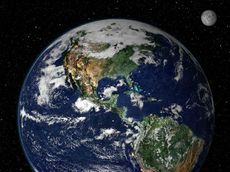The sixth mass extinction, explained
The populations of the world's wild animals have fallen by more than 50 percent and humanity is to blame. Here's everything you need to know.

The populations of the world's wild animals have fallen by more than 50 percent and humanity is to blame. Here's everything you need to know:
What's gone wrong?
As the human population has swelled to 7.5 billion, our species' massive footprint on planet Earth has had a devastating impact on mammals, birds, reptiles, insects, and marine life. We've driven thousands of species to the edge of extinction through habitat loss, overhunting and overfishing, the introduction of invasive species into new ecosystems, toxic pollution, and climate change. In the past 40 years, the number of wild animals has plunged 50 percent, a 2014 study found. And the World Wildlife Fund (WWF) estimates that populations of vertebrates — higher animals with spinal columns — have fallen by an average of 60 percent since 1970. The past 20 years have brought a 90 percent plunge in the number of monarch butterflies in America, a loss of 900 million, and an 87 percent loss of rusty-patched bumblebees. Only 3 percent of the original populations of the heavily fished Pacific bluefin tuna remain in the sea. "We are sleepwalking toward the edge of a cliff," said Mike Barrett, executive director at WWF.
Subscribe to The Week
Escape your echo chamber. Get the facts behind the news, plus analysis from multiple perspectives.

Sign up for The Week's Free Newsletters
From our morning news briefing to a weekly Good News Newsletter, get the best of The Week delivered directly to your inbox.
From our morning news briefing to a weekly Good News Newsletter, get the best of The Week delivered directly to your inbox.
How many species are already extinct?
Scientists can only guess. Earth is home to between nine million and as many as one trillion species — and only a fraction have been discovered. Vertebrate species have, however, been closely studied, and at least 338 have gone extinct, with the number rising to 617 when one includes those species "extinct in the wild" and "possibly extinct." Recent vertebrate extinctions in the wild include the northern white rhino, which lost its last male member in 2018, and Spix's macaw, a blue parrot native to Brazil. But 99 percent of Earth's species are invertebrates, and 40 percent of the species known to have died off since 1500 were land snails and slugs. One, the Hawaiian tree snail, died out on New Year's Day, when its final member, George — dubbed "the world's loneliest snail" — passed at age 14. "I'm sad," said Rebecca Rundell, a biologist at State University of New York. "But really, I'm more angry, because this was such a special species, and so few people knew about it."
How many species are endangered?
There are 26,500 species threatened with extinction, according to the International Union for Conservation of Nature (IUCN), a global network of some 16,000 scientists. That includes 40 percent of amphibian species, 33 percent of reef-building corals, 25 percent of mammals, and 14 percent of birds. There are now only 7,000 cheetahs left, and the number of African lions is down 43 percent since 1993. Only about 100 Amur leopards — often poached for their beautiful coats — are left in the wild in southeastern Russia and China. A third of insect species are endangered, and the total number of bugs on Earth is dropping by 2.5 percent every year. "There are examples of species all over the world that are essentially the walking dead," said biologist Paul Ehrlich.
Sign up for Today's Best Articles in your inbox
A free daily email with the biggest news stories of the day – and the best features from TheWeek.com
Is a mass extinction underway?
Possibly. Many scientists now believe humans are living through a "mass extinction," or an epoch during which at least 75 percent of all species vanish from the planet. Earth has supported life in some form for about 4.2 billion years. The previous five mass extinctions occurred over the past 450 million years; the last one occurred about 66 million years ago, when the aftermath of a massive asteroid strike wiped out the dinosaurs. These prior events differed from the current one, though, in that they were triggered by a natural disaster or change in Earth's climate. This time, it's humanity that is driving the mass die-off, which is why a debate is now afoot in scientific circles over whether to rechristen our current geological epoch as the "Anthropocene Era" — from anthropos, for "man," and cene, for "new."
How fast is this happening?
Extremely fast. Species extinction is an ordinary part of the natural processes of our planet; in fact, 99 percent of all species that ever lived on Earth are gone. It's the pace of recent extinctions that is alarming. More than half of the vertebrate extinctions since 1500 have occurred since 1900. Generally speaking, scientists assess the current rate of extinction as somewhere between 100 to 10,000 times Mother Nature's regular pace.
What are the consequences?
Potentially enormous. The loss of species can have catastrophic effects on the food chain on which humanity depends. Ocean reefs, which sustain more than 25 percent of marine life, have declined by 50 percent already — and could be lost altogether by 2050. This is almost certainly contributing to the decline of global marine life, down — on average — by 50 percent since 1970, according to the WWF. Insects pollinate crops humans eat. "This is far more than just being about losing the wonders of nature, desperately sad though that is," the WWF's Barrett said. "This is actually now jeopardizing the future of people. Nature is not ‘nice to have' — it is our life-support system."
Can extinct species be resurrected?
Using DNA technology, scientists are working on recreating species that have disappeared. The technology, called "de-extinction," is likely at least a decade off, although there are a few possible ways to go about it. The first, "back-breeding," involves mating examples of a living species with traits similar to the extinct species. The second option is cloning — famously attempted in 2009 using the DNA of an extinct Pyrenean ibex and its closest living cousin, the common goat. (The offspring lived only seven minutes.) The third option is to edit the genes of an extinct species' closest living analog to obtain an approximation. Such work is now underway with the passenger pigeon and woolly mammoth. "If you're willing to accept something that is an elephant that has a few mammoth genes," said Beth Shapiro, an evolutionary biologist, "we're probably closer to that." But don't expect to see a Tyrannosaurus rex or velociraptor like the ones in Jurassic Park. De-extinction requires an extinct species' DNA, and that molecule of life only lasts about a million years before degrading. Dinosaur DNA would be far older.
Create an account with the same email registered to your subscription to unlock access.
-
 Today's political cartoons - April 14, 2024
Today's political cartoons - April 14, 2024Cartoons Sunday's cartoons - Trump Derangement Syndrome, social media dangers, and more
By The Week US Published
-
 5 rambunctious cartoons about the House speakership standoff
5 rambunctious cartoons about the House speakership standoffCartoons Artists take on Mike Johnson's night terrors, the Speaker's chair, and more
By The Week US Published
-
 The Week Unwrapped: Ultrarunning, menswear and a meaty row
The Week Unwrapped: Ultrarunning, menswear and a meaty rowPodcast Is the "Hardest Geezer" a high-endurance trendsetter? Will Ted Baker survive? And what's the beef with lab-grown meat?
By The Week Staff Published
-
 Race to the Moon: the manned missions to lunar surface
Race to the Moon: the manned missions to lunar surfaceThe Explainer China and US locked in battle for future dominance of Earth's satellite and its precious resources
By Harriet Marsden, The Week UK Published
-
 Good news stories from 2023
Good news stories from 2023In Depth Huge strides have been made in medicine and science, and records broken in women's sports and conservation
By Harriet Marsden, The Week UK Published
-
 Why transparent wood offers 'promising future' for the environment
Why transparent wood offers 'promising future' for the environmentThe Explainer New techniques that change structure of material could mean tougher and more efficient windows and phone screens
By Harriet Marsden, The Week UK Published
-
 How Iceland deals with volcanic activity
How Iceland deals with volcanic activityThe Explainer Scientists are closely monitoring seismic activity as threat of eruption looms
By Julia O'Driscoll, The Week UK Published
-
 Young teen wins top science prize for soap that can treat skin cancer
Young teen wins top science prize for soap that can treat skin cancerSpeed Read Memory of Ethiopian workers out in the sun inspired US schoolboy to make cell-reviving soap
By Keumars Afifi-Sabet, The Week UK Published
-
 Starbucks launches olive oil coffee
Starbucks launches olive oil coffeefeature And other stories from the stranger side of life
By Chas Newkey-Burden Published
-
 ‘Planet-killer’ asteroid will cross Earth’s orbit
‘Planet-killer’ asteroid will cross Earth’s orbitfeature And other stories from the stranger side of life
By Chas Newkey-Burden Published
-
 Ancient microbes on Mars blamed for climate change
Ancient microbes on Mars blamed for climate changeSpeed Read Researchers suggest organisms may show that ‘common fate of life in the universe is to self-destruct’
By The Week Staff Published